Waves and Optics
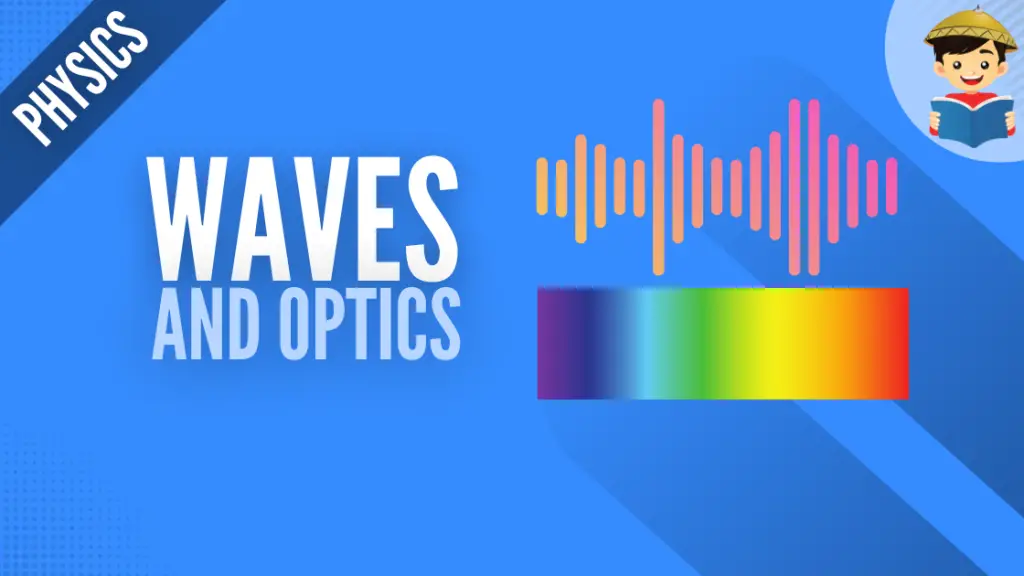
When we talk about waves, we usually think of the ocean, wave pools, or even our hair. There are other types of waves, however, that we usually are not aware of, like sound and light.
In this reviewer, we will learn about waves and discuss their properties, kinds, and behavior. We are also going to give a brief overview of optics.
Click below to go to the main reviewers:
Table of Contents
Part I. Waves
A. Mechanical Waves
If you try throwing a stone into a still lake, you will notice that it creates a disturbance in the lake. This is usually where waves originate – from an event or disturbance that propagates.
A wave is a traveling disturbance that carries energy from one place to another.
Aside from the radial waves in the example, waves can also be linear waves, like the waves you create when you exercise using a rope. Both these waves travel through a material or medium and are what we call mechanical waves.
Mechanical waves can be transverse waves, where the disturbance is perpendicular to the direction of the wave, or longitudinal waves, where the disturbance is parallel to the wave’s direction.
Both types of mechanical waves can be demonstrated using a slinky. When you shake the slinky’s end from side to side, a transverse wave is formed. On the other hand, when you push and pull the slinky rapidly towards or away from you, a longitudinal wave is formed. The parts of the slinky that are compressed are called compression, while the parts that are stretched in between are called rarefaction. A perfect example of a longitudinal wave is sound.
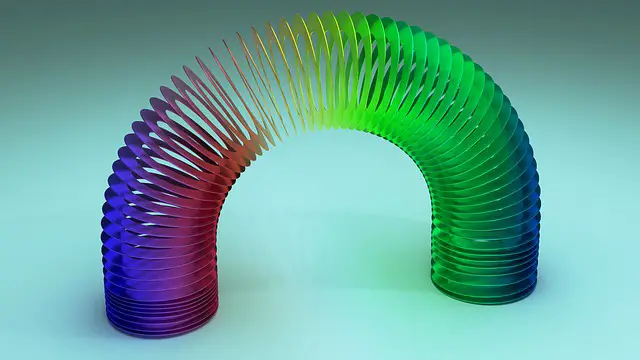
In mechanical waves, the medium does not travel with the wave, only the energy. If you have watched an international football game, for example, you probably have noticed how the crowd does the human wave, where the people act like a wave that travels without changing their location, and the overall motion or energy of the wave moves through the crowd.
Unlike mechanical waves, some waves do not need any medium at all. These waves are known as electromagnetic waves. A perfect example of this is light since it can travel through the vacuum, which allows us to see the stars in the night sky. We will emphasize this topic in the next section.
B. Anatomy of a Wave
Waves are usually described and measured by five things: the amplitude, the wavelength, the period, the frequency, and the wave speed.
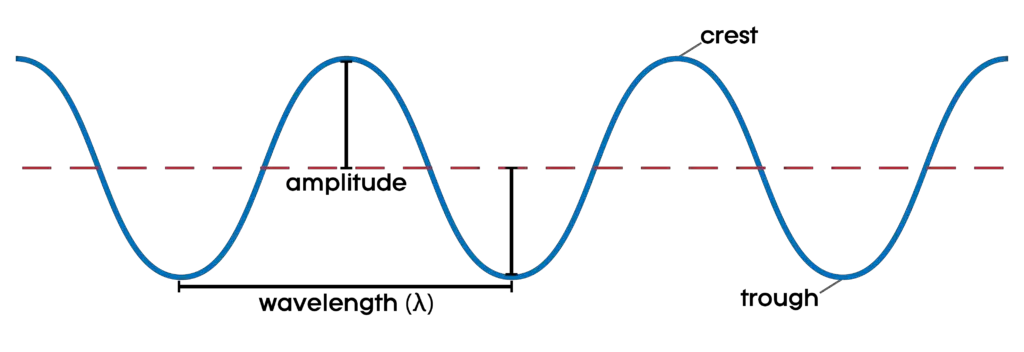
Both amplitude and wavelength describe the distance of the wave.
Amplitude refers to the displacement of the wave. It is measured from the height of the highest point of the wave (called a crest) to the midline. The greater the amplitude, the higher the energy.
The wavelength, on the other hand, measures the horizontal distance between cycles. Simply put, it measures the length of one cycle.
Period and frequency describe the time involved in a wave.
The wave period refers to the time required to complete one cycle. The wave frequency is the opposite of the period since it measures the number of waves per unit of time. This is usually measured in Hertz (1 Hz).
The speed of the wave is measured using wavelength and frequency.
Mathematically,
v = λf
where λ signifies the wavelength and f stands for the frequency.
C. Wave Phenomena
All types of waves have certain features or behaviors caused by the wave’s interactions with its surroundings. These are reflection, refraction, diffraction, and interference.
Reflection occurs when a wave bounces off a material and travels back in the direction from which it originated. A perfect example is an echo we hear when we shout at the top of the mountain.
Refraction occurs when a wave travels from one medium to another. You will see this when placing a pencil in the water. You probably have noticed that the pencil appears to be bent, and that is because the light waves refract as they move from air to water.

Diffraction describes the movement of the waves as it passes through an opening or barrier. This is why you can still hear the noise coming from the next classroom when you were still in high school.
Waves traveling through a medium can also meet, and when they do, interference occurs. When waves interfere, they can come together and create a larger wave, or they can come together and cancel each other out partially or completely.
D. Sound
Sound is also brought to our ears through longitudinal waves.
It usually initiates with a vibration, like when you pluck your guitar strings.
Like any type of mechanical wave, sound also requires a medium to travel through, like solid, liquid, or gas. Sound cannot travel in a vacuum which is the reason why there is no sound in space.
Usually, sound travels through air, causing vibration in atmospheric molecules as it passes. This is the case with ocean waves, where molecules are displaced as the wave passes.
Each sound wave carries the same frequency as the vibration that initiated it. When the frequency is high, there are a lot of vibrations per second and vice versa. This is also related to the pitch, which refers to the highness or lowness of the sound. The higher the frequency, the higher the pitch.
Another important property of sound is the amplitude which also measures the loudness of sound. The higher the amplitude, the louder the sound. Since amplitude is related to energy, the latter also has a counterpart in sound known as intensity. Sound intensity measures how much energy the wave contains.
Did you know that sound travels faster in water than in air?
Mechanical waves travel at a constant speed for a given medium, hence, their speed varies depending on where it moves. For example, when sound moves in the air, its speed is around 343 m/s. On the other hand, when sound travels in water, its speed is around 1481 m/s. The speed at which a wave propagates is equal to wavelength times the frequency.
E. Doppler Effect
You have probably noticed how the sound of the ambulance changes as it goes nearer to your location. This happens because of the phenomenon known as the Doppler effect. To understand this phenomenon, let us first discuss the actual and apparent frequency.
The actual frequency is the true frequency of a wave, regardless of external factors and the location of the observer. Let’s say, for example, that the ambulance has an actual frequency of 540 Hz. On the other hand, apparent frequency is the frequency that an outside observer perceives. It may be higher or lower than the actual frequency, depending on the movement of the wave source.

The change of shift in frequency due to the movement of a wave source is called the Doppler effect. According to the Doppler effect, the observer perceives an upward frequency shift when the wave source is approaching, while the observer perceives a downward shift in frequency when the wave source is retreating. This is why you hear a frequency higher than the actual one when the ambulance approaches you while you hear a lower frequency sound when it is far from you.
Doppler effect is not only limited to sound waves as it also occurs on other types of waves such as light.
Part II. Optics
Our world is filled with great wonders and colors, from blue skies to green grass. We appreciate all of these because of optics which deal with the behavior of light and other electromagnetic waves. Let us learn more about this as we read this chapter.
A. Light
Some of us are afraid of the darkness; that is why we seek the light. Way back, we all know that light exists, but we do not know what it is. Let us shed some light on this topic as we break down what light is.
1. Wave-Particle Duality
The earliest attempt to discuss the nature of light as a particle started with Newton and his corpuscular theory, which states that light emitted by a source is composed of tiny, massless particles called corpuscles. This theory can perfectly explain the concept of reflection, but it could not explain other phenomena.
Not long after, evidence of light being a wave has become so persuasive, and the biggest breakthrough was when James Clerk Maxwell discovered the existence of electromagnetic waves.
The nature of light as a particle does not end, however, since the energy carried by light waves during emission and absorption reveals a particle aspect of light called photons or quanta. This contradiction has been solved when the field of quantum theory was established, which states that light (and other electromagnetic waves) is both a particle and a wave.
In optics, we will emphasize the aspect of light as a wave.
2. Light as a Wave
We first introduced light as an electromagnetic wave, and like any type of wave, EM waves also have amplitude, frequency, and wavelength.
Different frequencies produce different kinds of light. If the light is visible, its frequencies correspond to different colors. When the frequency is greater than that of visible light, this can be classified as UV rays, X-rays, and gamma rays. On the other hand, when the frequency is less than that of visible light, this can be classified as infrared, microwaves, and radio waves.
These waves can be summarized in an electromagnetic spectrum.
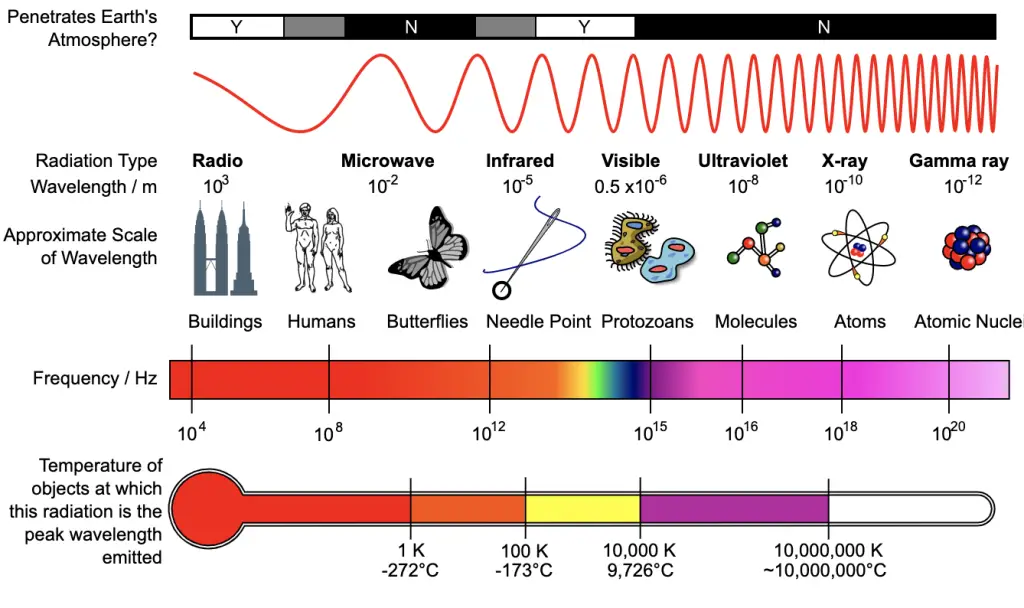
All electromagnetic radiation moves at the speed of light. In this case, the speed of light can be expressed mathematically as
c = λf
where c is the speed of light which is equal to 3×108 m/s.
3. Colors and Refraction
We all have probably heard of ROYGBIV, which describes the color of the rainbow. However, this is more than just the colors of the rainbow because these colors represent visible light.
ROYGBIV stands for the colors Red, Orange, Yellow, Green, Blue, Indigo, and Violet. These colors are arranged from the lowest frequency to the higher frequency.

When light hits an illuminated object, some light would be absorbed while some would be reflected, depending on the property of the material.
When light is absorbed, some materials absorb only particular colors while reflecting others. These reflected colors are the ones we see, so when we see red objects, it means that red is the predominant color that is reflected to meet our eyes.
In case an object absorbs all wavelengths of visible light, it will appear black. When an object reflects all wavelengths of visible light, it will appear the same color as the light.
4. Refraction of Light
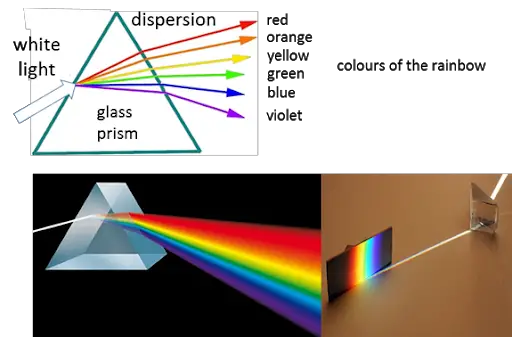
When light bends as it travels from one medium to another, refraction occurs.
A perfect example would be the light that you see when you are underwater. This light travels from air to water, and when light hits the water, the light ray changes direction, and an angle of refraction occurs. This happens when the velocity of light changes as it changes medium since light travels slowly through water than through air.
Another example is when light passes through a prism at an angle, where white light splits into all the individual colors it contains since the different wavelengths of visible light are slowed down by some degrees. Since white light can be separated into all colors, all colors can also be combined to get white light.
5. Scattering of light
If you ever wondered why the sky is blue or why the sunset is red, well, that is because of physics!
When we look at the sky during the day, the light that we see is the sunlight that has been absorbed and then re-radiated in all directions by all the gases and particles in the air. These particles scatter the higher frequency and shorter-wavelength portions of the visible light spectrum more easily. This process is called scattering.
While all colors are scattered in all directions in the Earth’s atmosphere, colors like violet, indigo, and blue are scattered more since they travel in shorter and smaller waves. However, our eyes are more sensitive to blue light, resulting in the blue sky we see most of the time.
As the sun starts to set, the sunlight has to travel longer distances, and a considerable amount of the blue light is removed by scattering. White light minus blue light looks yellow or red, which explains the yellow or red hue that we so often see from the setting sun.

The color that we see in our sky depends on the atmosphere. In our case, the most abundant gas in our atmosphere is nitrogen, followed by oxygen, and these particles can easily scatter light with higher frequency and shorter wavelengths. If the earth has no atmosphere, the sky would appear as black in the daytime as it does at night.
In case the earth has an atmosphere with different particles (like carbon dioxide, for an instance), different light would be scattered, and we will see a different color in our sky.
B. Mirrors

All of us use a mirror, especially when we look at ourselves. We know that it produces reflection, allowing us to see our image. But how does it happen?
If we touch a mirror, we can see that its surface is smooth and flat, so when light hits it, it produces an image that is clear and not distorted. This type of mirror is called a plane mirror.
Another type of mirror is a spherical mirror, which has a consistent curve and a constant radius of curvature – a sphere-shaped mirror. This type of mirror can be convex or concave, depending on the side where you will put the mirrored surface.
If you place the mirrored surface outside the spherical curve, you have a convex mirror. This type of mirror always produces images that are upright, virtual, and smaller than the object. On the other hand, you will have a concave mirror when you place the mirrored surface inside the spherical curve. This type of mirror produces different images, depending on whether the object is placed further away from the mirror than the focal point or inside the focal point.
C. Lenses
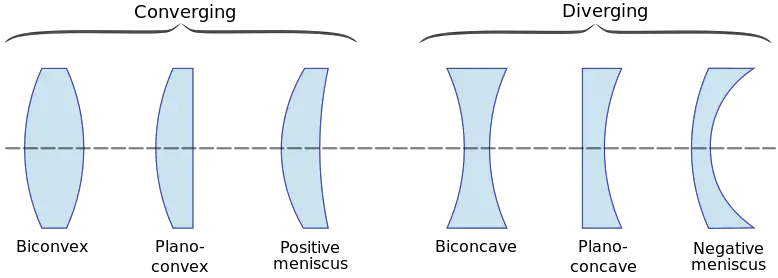
If you have poor eyesight, you have probably heard of contact lenses, but what are these?
A lens is an instrument that bends light to allow the user to see the world around them in a different way. There are different types of lenses, and each type will help you see differently.
Simple lenses use a single lens to refract light. A good example of this is a magnifying glass. On the other hand, the compound lens uses multiple lenses. If you have used a compound microscope during your biology class, you have probably noticed how objects were magnified greatly.
Like mirrors, lenses can also be concave or convex. Concave lenses are thinnest in the middle and so bend light outwards, while convex lenses are thickest at the middle, bending light in towards a central focal point.
Next topic: Electricity and Magnetism
Previous topic: Fluid Mechanics
Return to the main article: The Ultimate Physics Reviewer
Download Article in PDF Format
Test Yourself!
1. Practice Questions [PDF Download]
2. Answer Key [PDF Download]
Written by Mary Joy Montenegro
Mary Joy Montenegro
Mary Joy Montenegro is a licensed professional teacher who obtained her Master’s Degree in Teaching Physics at De La Salle University under the Department of Science and Technology Scholarship. Aside from teaching, she also loves traveling and meeting other people.
Copyright Notice
All materials contained on this site are protected by the Republic of the Philippines copyright law and may not be reproduced, distributed, transmitted, displayed, published, or broadcast without the prior written permission of filipiknow.net or in the case of third party materials, the owner of that content. You may not alter or remove any trademark, copyright, or other notice from copies of the content. Be warned that we have already reported and helped terminate several websites and YouTube channels for blatantly stealing our content. If you wish to use filipiknow.net content for commercial purposes, such as for content syndication, etc., please contact us at legal(at)filipiknow(dot)net